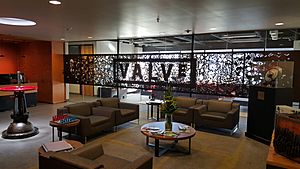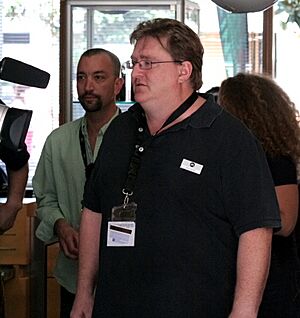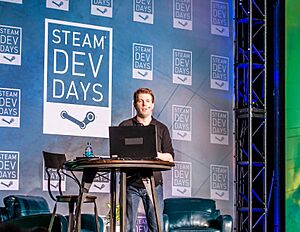Valve Corporation facts for kids
 |
|

Valve's former offices in Bellevue, Washington
|
|
|
Formerly
|
Valve, L.L.C. (1996–2003) |
|---|---|
| Private | |
| Industry |
|
| Founded | August 24, 1996 in Kirkland, Washington, US |
| Founders | |
| Headquarters |
,
US
|
|
Key people
|
|
| Products | |
| Total equity | US$10 billion (2019) |
| Owner | Gabe Newell (>50%) |
|
Number of employees
|
336 (2021) |
| Subsidiaries |
|
|
|
|
Valve Corporation, also known as Valve Software, is an American company that makes and publishes video games. They are also famous for their online store, Steam, where people can buy and play games. Valve is based in Bellevue, Washington, USA. They created popular game series like Half-Life, Counter-Strike, Portal, Team Fortress, Left 4 Dead, and Dota.
Gabe Newell and Mike Harrington, who used to work at Microsoft, started Valve in 1996. Their first game, Half-Life (released in 1998), was a huge hit. It was a first-person shooter (FPS) game that changed how many games were made. Mike Harrington left the company in 2000. In 2003, Valve launched Steam, which is now a very popular online store for games. After that, they released many more successful games. These included Half-Life 2 (2004), Team Fortress 2 (2007), Left 4 Dead (2008), and the puzzle games Portal (2007) and Portal 2 (2011). They also made the online battle game Dota 2 (2013).
During the 2010s, Valve made fewer new games. Instead, they started trying out new gaming hardware and virtual reality (VR) technology. In 2015, they released the Steam Machine, which was a type of gaming computer, but it didn't sell very well. They also created VR headsets like the HTC Vive and Valve Index. In 2020, Valve went back to the Half-Life series with Half-Life: Alyx, a big VR game. More recently, in 2022, Valve launched the Steam Deck, a handheld gaming device that lets you play PC games anywhere.
Valve has a unique way of working. Employees often choose what projects they want to work on. They test their games a lot during development, using feedback to make them better. This is called playtesting. By 2012, Valve had about 250 employees. Most of Valve's money comes from Steam, their online game store. A report from December 2024 stated that Valve earned about $5 billion in 2023.
Contents
History
How Valve Started and Half-Life (1996–2003)

Valve was founded in 1996 by Gabe Newell and Mike Harrington. Both had previously worked at Microsoft. They started Valve, L.L.C. in Kirkland, Washington, on August 24, 1996.
Valve's first game was Half-Life. It was a first-person shooter (FPS) game with scary parts. Valve used a modified version of the Quake engine to create their own GoldSrc engine for the game. After some searching, Valve found a company called Sierra On-Line to publish their game.
Half-Life came out in November 1998. It was a huge success with both players and critics. The game was known for its realistic feel and continuous story. Many people say it changed the FPS game genre forever.
Valve worked with other companies to make more Half-Life games. They also acquired the team behind the popular Counter-Strike game mod. This led to a standalone Counter-Strike game. Mike Harrington sold his share of Valve to Gabe Newell in 2000. Valve later gained full ownership of the Half-Life games and the right to sell its games online.
The Source Engine, Steam, and Half-Life 2 (2003–2010)
In 2003, Valve moved its offices to Bellevue, Washington. They also changed their company name to Valve Corporation. The company moved to bigger offices in Bellevue in 2010 and again in 2016.
Valve started making Half-Life 2 soon after the first game. They used their brand-new Source engine for this game. Half-Life 2 was released in 2004. It was praised for its advanced physics and strong story. By 2011, it had sold 12 million copies.
In 2002, Valve launched Steam. This was an online store and platform for delivering games. At first, Steam only offered Valve's own games. It was even required to install Half-Life 2. Over time, Steam grew to include games from many other companies. As Valve started publishing its own games through Steam, it changed how the company was organized.
After taking five years to make Half-Life 2, Valve decided to make shorter games more often. They released Half-Life 2: Episode One in 2006 and Episode Two in 2007. In 2007, they also released the multiplayer game Team Fortress 2 and the puzzle game Portal. Valve also acquired Turtle Rock Studios, who developed Left 4 Dead (2008).
Focusing on Services and Hardware (2010–2014)
In 2009, Valve hired IceFrog, who created the popular Defense of the Ancients game mod. IceFrog led the creation of Dota 2, which was released in 2013. Valve also started The International in 2011. This is a big yearly esports tournament for Dota 2. Players help fund the prize pool by buying special items in the game.
Valve released Portal 2 in April 2011. Like the first Portal, students helped develop new gameplay ideas for it. By 2011, Valve was worth billions of dollars and had about 250 employees. Most of Valve's money came from Steam.
Around this time, Valve started releasing fewer new games. Instead, they focused on updating existing games like Left 4 Dead 2 and Team Fortress 2 through Steam. They also began investing in making gaming hardware. Gabe Newell wanted Valve to be more like Nintendo. This meant making games and hardware together to create new experiences. Valve focused on virtual reality (VR) technology. In 2015, Valve released the Steam Machine, a line of gaming computers, but it did not sell well.
Source 2, Virtual Reality, and Half-Life: Alyx (2015–Present)
Valve announced its new Source 2 game engine in March 2015. They updated Dota 2 to use this new engine in September of that year. In 2015, Valve worked with the company HTC to create the HTC Vive. This was a VR headset released in 2016. Valve also made some VR minigames called The Lab.
Valve realized that many players wanted a bigger VR game. They started working on a major VR title. They tried different ideas and eventually decided to make a new Half-Life game for VR. The team felt that VR was a great way to bring the series back.
Full development of the VR Half-Life game began in late 2016. It involved the largest team in Valve's history. In April 2018, Valve acquired Campo Santo, a game studio known for Firewatch. Campo Santo helped develop the new Half-Life game.
In June 2019, Valve released its own VR headset, the Valve Index. They also released Dota Underlords, an auto battler game based on a Dota 2 community mod.
In March 2020, Valve released Half-Life: Alyx, a VR game. It received great reviews and was seen as a "must-have" game for VR. In 2021, Valve worked with Netflix on Dota: Dragon's Blood, an animated TV series based on Dota. In February 2022, Valve released the Steam Deck. This is a portable gaming system that runs on SteamOS. In September 2023, Valve released Counter-Strike 2.
In 2024, Valve began testing a new multiplayer game called Deadlock. It combines elements of a hero shooter and a MOBA.
How Valve Works
Teamwork and Organization
At first, Valve had a typical company structure with managers and deadlines. But as Valve started publishing its own games through Steam, they found this structure wasn't working well.
After making Half-Life 2, Valve changed to a flat organization. This means that, apart from the top leaders, there are no bosses. Employees can choose what projects they want to work on. Valve's marketing manager, Doug Lombardi, explained that teams come up with ideas themselves. This way, employees take ownership of their work. Gabe Newell said this structure works well for some people, but not for everyone.
Even without bosses, some employees have more influence because they have been at the company longer. Decisions are often made together as a group. Valve also uses a system called Overwatch to get feedback from experienced team members.
The success of Steam means Valve doesn't rely only on new games. Sometimes, it can be hard to get enough people to work on a project. This can lead to games being canceled. In 2020, Valve said this had slowed down their game releases in the 2010s. Their VR projects and Half-Life: Alyx helped the company focus on shared goals.
Valve had about 60 employees in 2003. Between 2012 and 2021, they had around 350 employees. Employees work in areas like game development, Steam development, and hardware development.
What is Valve Time?
Valve time is a funny term used in the gaming world. It describes how Valve's game release dates often get delayed. It means the "promised" date for a game is usually different from the "actual" release date. Valve has even joked about this term themselves. They say delays happen because their teams focus on making games great, rather than sticking to strict deadlines.
Testing Games (Playtesting)
Valve tests its games a lot from the very beginning of development. They use the results to make games better. They believe that game designers are like "experimental psychologists." This means they learn by trying things out and seeing how players react.
For example, a writer at Valve, Chet Faliszek, once realized that if many testers had the same problem, it was the game's fault, not the players'. He gave an example where a small change to a game's look made every tester miss a ladder. This showed them they needed to fix the game.
Playtesting helps Valve make sure players have the best experience. If something exciting happens by chance during a test, developers try to make it happen for every player.
What Valve Makes
Video Games
Valve develops and publishes many popular games. These include the single-player Half-Life and Portal series. They also make multiplayer games like Counter-Strike, Team Fortress 2, Dota 2, and Day of Defeat. Valve also published Left 4 Dead and developed Left 4 Dead 2.
Game Engines
Valve has created several game engines. These are the basic software tools used to build games.
- GoldSrc was based on a modified Quake engine. It was used for Half-Life.
- Source was built from scratch by Valve. It was used for most of Valve's games in the early 2000s, like Half-Life 2 and the Portal series.
- Source 2 is an improved version of the Source engine. It was released in 2015 and is used for games like Dota 2, Counter-Strike 2, and Half-Life: Alyx.
Steam: The Online Game Store
Steam is Valve's online store and service for digital games. Valve announced it in 2002 and launched it in September 2003. At first, it was used to deliver updates for Valve's online games.
Steam grew to offer thousands of games from many different publishers. By January 2018, over 150 million people had registered accounts on Steam. In August 2017, Steam had over 67 million monthly users. In September 2024, Valve updated its Steam rules to require disputes to proceed in court, with no option of arbitration.
Steam Machine: Gaming Computers
Gabe Newell was concerned about Windows becoming a more closed system. He saw Linux as a good alternative for gaming.
In 2012, Valve announced they were working on a special computer for living rooms. It was called the "Steam Box" by the media. This led to SteamOS, a free operating system based on Linux. SteamOS was designed for gaming and included features like game sharing and parental controls. In 2015, companies like Alienware released their versions of the Steam Machine. However, they did not sell very well.
Valve Index and Virtual Reality
In March 2015, Valve and the electronics company HTC showed off SteamVR and the HTC Vive. This was a virtual reality platform and headset. It was special because of its "Lighthouse" tracking system. This system allowed players to walk around a room while playing VR games.
In June 2019, Valve released its own VR headset, the Valve Index. It was designed to be a high-end device with a wider view and faster refresh rate. It came with new controllers that strapped to your hands and could detect individual finger movements.
Steam Deck: Portable Gaming
The Steam Deck was announced in July 2021. It is a handheld game console, similar to the Nintendo Switch. It lets you play many PC games from Steam on the go. You can also connect it to a separate dock to play on a TV or monitor. The Steam Deck started shipping to players in February 2022.
See also
 In Spanish: Valve Corporation para niños
In Spanish: Valve Corporation para niños



